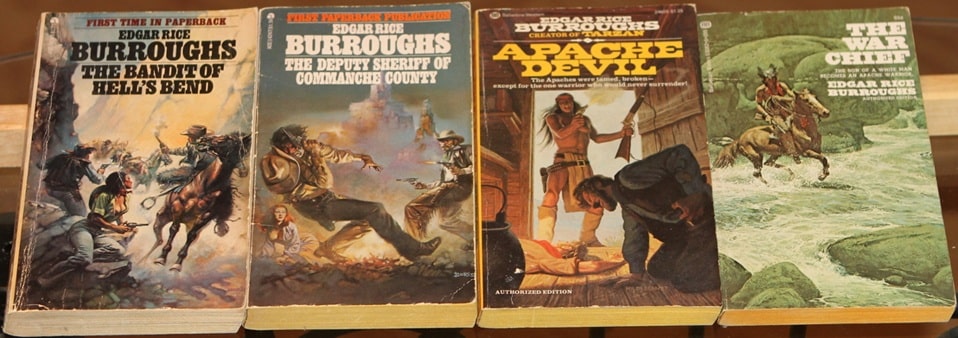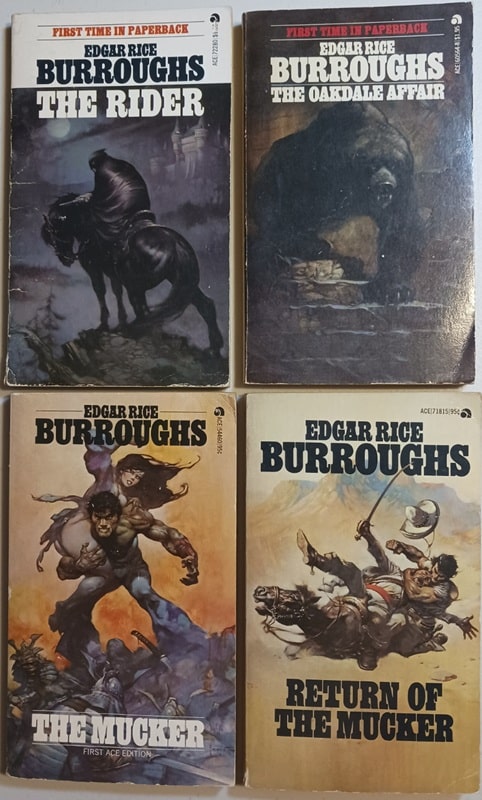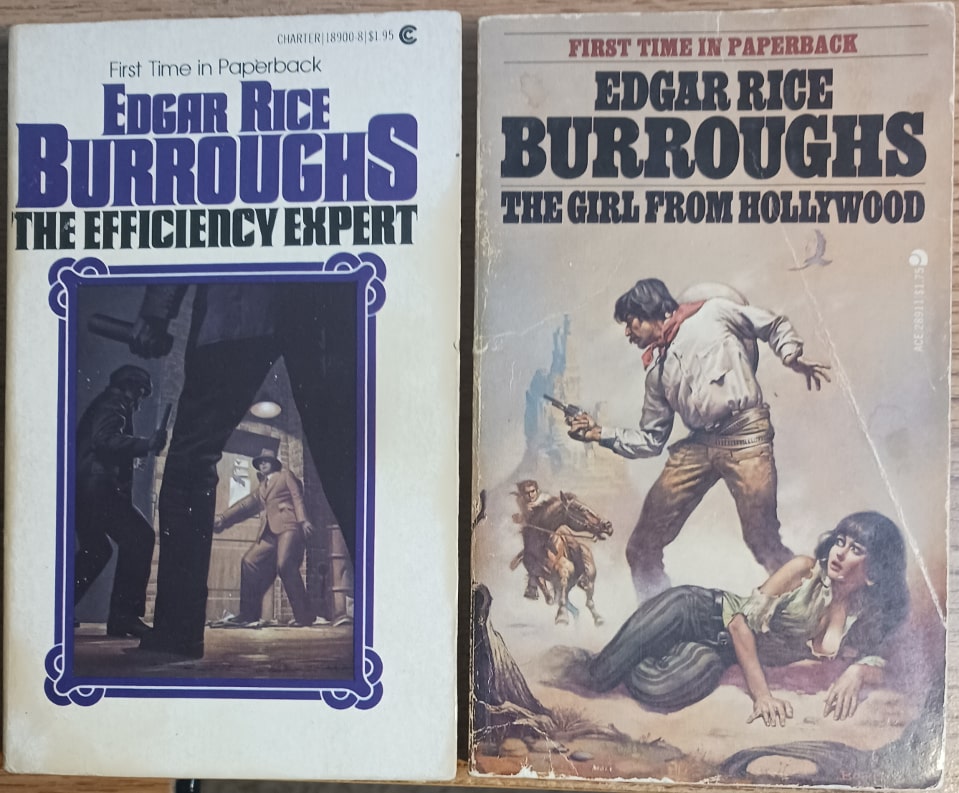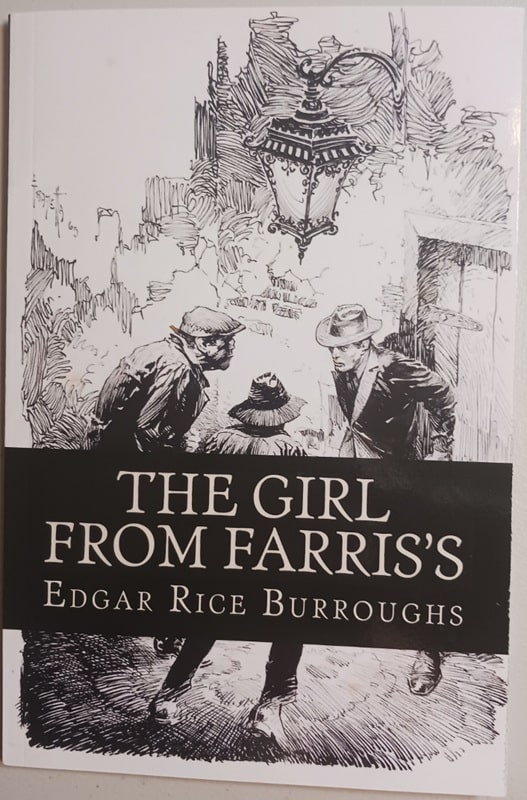The Fiction of Edgar Rice Burroughs, Part III: The Westerns and The Mucker

Like many pulp writers of his day, ERB dipped his toes into the western genre. He wrote four: two pretty standard ones and two that incorporate the Native American experience. He knew something of what he wrote, having worked on his brother’s ranch in Idaho at age 16, and having served with the 7th cavalry in Arizona in the late 1890s.
His first standard western was The Bandit of Hell’s Bend (1924), followed by The Deputy Sheriff of Commanche County in 1940. Both of my copies are later printings from Ace with very cool Boris illustrations. I like these better than many of Boris’s paintings because they seem less static. He does a good job of portraying action here.
In Bandit, we have a disgraced ranch foreman and a young woman who has inherited the ranch, and various villains who want to steal the ranch from her because they know there’s silver on it. The foreman, Bull, has to rise to the occasion. There’s great action and pretty good plotting, although you’ll probably figure it out pretty soon. And, as always, ERB creates sympathetic heroes and dastardly villains.
In Deputy Sheriff, a cowboy named Buck Mason is suspected of a murder he didn’t commit, and he has to run and hide until he has a chance to prove his innocence. This plot is not as good as Bandit but it gets the job done to showcase ERB’s lightning paced tale.
ERB’s other two westerns are connected and center very strongly on the Native American experience. The hero, though, is a white boy who is taken captive by Apaches and raised as Geronimo’s adopted son. He is given the Apache name of Shoz-Dijiji (Black Bear), for having killed one at a young age, and he grows up hating whites.
These books are The War Chief (1927), and Apache Devil (1933). Although there are some stereotypical elements to these books, they show that ERB had very strong sympathies for the Apache and disapproved of the way they had been treated by whites.
I found all of these books well worth reading, though the Apache books have stayed with me the longest. The cover art for The War Chief is magnificent and is by Frank McCarthy. The Apache Devil cover looks to be signed by Hildebrandt.

ERB wrote a three book series generally called The Mucker. They were first published in magazines in the mid to late 1910s, but I have much later reprints, of course, from the 1970s. All of mine, shown here, are from Ace books with Frazetta covers. I particularly like the first book cover, although all are cool.
The Mucker (1914). Billy Byrne is born on the mean streets of Chicago and grows up a criminal. After being accused of murder, he flees to San Francisco and ends up shanghaied. A shipwreck leaves him and a beautiful high society girl stranded in an east Asian jungle and she needs rescuing. I really liked the development of the character here. Through love, Billy learns how to be a decent human being and becomes quite a hero.
The Return of the Mucker (1916). This book finds Billy trying to clear himself of his previous murder charges and failing. He ends up in Mexico in the midst of a revolution. And it so happens that his love interest from the first book, Barbara, is also there. The Mucker was a very fine novel but the sequel is pretty weak. Coincidences pile upon coincidences until it’s pretty hard to suspend belief. But it still has the action rolling. This one could easily be counted as one of his westerns given the setting.
The Oakdale Affair (1918). I’m not sure what ERB was striving for with this book. It’s got mystery elements, gothic elements, horror elements, western type elements. He put everything and the kitchen sink into this one. But it worked and I enjoyed it. It is only peripherally related to the Mucker stories in that it features a hobo character that appeared in The Return of the Mucker.
I included ERB’s The Rider here because of the Frazetta cover and because it was at one point published in a double with The Oakdale Affair. But it’s not part of the Mucker series. It involves a bandit called “The Rider” who exchanges places with a prince (Boris) who is about to be married to the princess of another European duchy (neither of whom want to marry the other). Chaos ensues. ERB crammed a lot of action and plot twists into this short work.

My favorite genres are Fantasy, SF, Westerns, Horror, and Thrillers. I don’t read a lot of straight mysteries and read relatively little “mundane” fiction. By mundane, I mean fiction set in a modern world where the happenings are portrayed as realistic. After reading ERB’s westerns and everything he wrote with fantastic elements, I was left with three books: The Girl from Hollywood, The Efficiency Expert, and The Girl From Farris’s.
They were also among the more difficult ERB books to find and were expensive, but I wanted them because they were… well, ERB. I got both Girl and Efficiency in 1970’s paperback form but couldn’t get Farris and finally ordered it in a modern paperback printed from public domain materials. Here are my capsule reviews.
The Girl from Hollywood (ACE, 1977, Boris Cover) is not quite a western. It takes place in the 1920s, but much is set in a western landscape and involves many western tropes. The plot involves a fine western family whose lives become entangled with Hollywood types. Some of these are basically good and recover from their evil natures while others never do.
As is typical of ERB’s work, there are coincidences that help the plot along, and there’s actually very little action compared to his typical story. However, the sheer narrative drive that ERB was able to bring to his tales keeps you reading. I finished it in one day, if not quite one sitting. Not my favorite work by him by far, but still enjoyable.

The Girl from Farris’s (Public Domain, from CreateSpace, 2017). The cover is by Frank Frazetta. An editorial note names Taylor Anderson as editor, and claims the publisher is Odin’s Library Classics. The text appears to be intact but the print is small and there are no indented paragraphs. I actually read this in ebook version, though, so I’ll just stick it on my shelves. I rather like the cover but don’t know where it came from.
“Farris’s” is a house of ill repute and June Lathrop a lady of the evening who is trying to escape it. She meets a young man — Ogden Secor — who wants to help her and fate keeps throwing them together. It’s a tale of redemption, which is an element in all three of these novels. One particularly interesting point is that Ogden is a failed Chicago businessman who tries to make a new life for himself in Idaho. ERB himself fled the business world of Chicago for his brother’s Idaho ranch. They say, “write what you know.”
The Efficiency Expert (Charter, 1979, cover by John Rush) is the last Burroughs book I’ve read, and very nearly the last one to exist that I hadn’t read. I left these three to last thinking they weren’t much up my alley. None of them have any fantastic elements. Efficiency Expert is a straightforward and realistically based story of a young man of quality who is down on his luck but never succumbs to corruption and wins out in the end. I was engrossed throughout. There’s certainly plenty of coincidence featured in the plot but I didn’t mind it much and even without a lot of action happening, it had narrative drive and kept my attention.
I’d rate Efficiency the best of the three, followed by Hollywood and Farris’s.
We’ll wrap up Burroughs next time with a look at his Hollow Earth tales.
Other installments in this series include:
The Fiction of Edgar Rice Burroughs, Part I: Sword and Planet
The Fiction of Edgar Rice Burroughs, Part II: Tarzan and The Land That Time Forgot
The Fiction of Edgar Rice Burroughs, Part III: The Westerns and The Mucker
The Fiction of Edgar Rice Burroughs, Part IV: The Hollow Earth and Pellucidar
Charles Gramlich administers The Swords & Planet League group on Facebook, where this post first appeared. His last article for Black Gate was The Fiction of Edgar Rice Burroughs, Part II: Tarzan and The Land That Time Forgot.
The Mucker is over-the-top loony and an absolute blast. (I picture ERB giggling helplessly as he wrote it.) The only thing of his that I can think of that’s at all comparable is Pirate Blood.
I delayed reading The Mucker because I was afraid I wouldn’t like it, that it would be too “tame.” As you indicate, I was wrong. It and the sequel are both delightfully fun tales.
I know I read The Mucker and its sequel about 25 years ago, but don’t have strong memories of either. I do still have to read the Westerns, and a number of the other standalones.
Donald Grant published a couple of his non-genre works at one point — You Lucky Girl (a screenplay, I believe) and Marcia of the Doorstep.
And the ERB estate published an edition of Girl from Hollywood that’s still available from their website.
Thanks for that info. I haven’t seen that screenplay. Will have to search it out.
[…] Rice Burroughs (Black Gate): Like many pulp writers of his day, ERB dipped his toes into the western genre. He wrote four: two […]